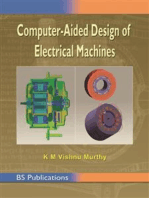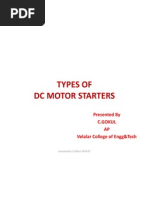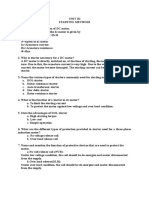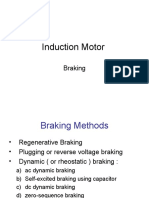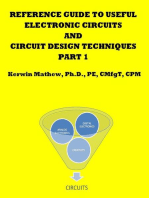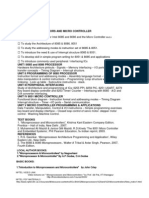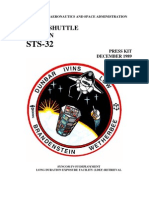DC Starter
DC Starter
Uploaded by
Gokul ChandrasekaranCopyright:
Available Formats
DC Starter
DC Starter
Uploaded by
Gokul ChandrasekaranOriginal Description:
Original Title
Copyright
Available Formats
Share this document
Did you find this document useful?
Is this content inappropriate?
Copyright:
Available Formats
DC Starter
DC Starter
Uploaded by
Gokul ChandrasekaranCopyright:
Available Formats
DC Starters
THREE POINT
STARTER
Diagram
It has three terminals L, F and A
The starter consists of starting resistance divided
into several sections and connected in series with
the armature.
The three terminals L, F and A of the starter are
connected respectively to the positive line
terminal, shunt field terminal and armature
terminal.
The other terminals of the armature and shunt
field windings are connected to the negative
terminal of the supply.
Operation
To start with, the d.c. supply is switched on with handle
in the OFF position.
The handle is now moved clockwise to the first stud. As
soon as it comes in contact with the first stud, the shunt
field winding is directly connected across the supply,
while the whole starting resistance is inserted in series
with the armature circuit
As the handle is gradually moved over to the final stud,
the starting resistance is cut out of the armature circuit in
steps. The handle is now held magnetically by the no-volt
release coil(NVR) which is energized by shunt field
current.
If the supply voltage is suddenly interrupted the no-volt
release coil(NVC) is demagnetized and the handle goes back to
the OFF position under the pull of the spring. If no-volt release
coil were not used, then in case of failure of supply, the handle
would remain on the final stud. If then supply is restored, the
motor will be directly connected across the supply, resulting in
an excessive armature current.
If the motor is over-loaded (or a fault occurs), it will draw
excessive current from the supply. This current will increase the
ampere-turns of the over-load release coil and pull the
armature C, thus short-circuiting the no-volt release coil. The
no-volt coil is demagnetized and the handle is pulled to the
OFF position by the spring. Thus, the motor is automatically
disconnected from the supply.
Drawbacks of 3 point starter
In a three-point starter, the no-volt release coil is
connected in series with the shunt field circuit so
that it carries the shunt field current. While
exercising speed control through field regulator,
the field current may be weakened to such an
extent that the no-volt release coil may not be
able to keep the starter arm in the ON position.
This drawback is overcome in the four point
starter.
4 point starter
only difference between a three-point starter
and a four-point starter is the manner in
which no-volt release coil is connected.
However, the working of the two starters is
the same. It may be noted that the three-
point starter also provides protection against
an open-field circuit. This protection is not
provided by the four-point starter.
Speed Control of
D.C.
Shunt Motors
1. Flux control method
It is based on the fact that by varying the flux
f, the motor speed (N 1/) can be changed
and hence the name flux control method. In
this method, a variable resistance (known as
shunt field rheostat) is placed in series with
shunt field winding as shown in Fig
Advantages
(i) This is an easy and convenient method.
(ii) It is an in expensive method since very little
power is wasted in the shunt field rheostat
due to relatively small value of Ish.
(iii) The speed control exercised by this method
is independent of load on the machine.
Disadvantages
(i) Only speeds higher than the normal speed
can be obtained since the total field circuit
resistance cannot be reduced below Rshthe
shunt field winding resistance.
(ii) There is a limit to the maximum speed
obtainable by this method. It is because if the
flux is too much weakened, commutation
becomes poorer.
2. Armature control method
This method is based on the fact that by varying
the voltage available across the armature, the
back e.m.f and hence the speed of the motor can
be changed. This is done by inserting a variable
resistance RC (known as controller resistance) in
series with the armature as shown in Fig
Due to voltage drop in the controller resistance,
the back e.m.f. (Eb) is decreased. Since N Eb,
the speed of the motor is reduced. This method
can only provide speeds below the normal speed
Disadvantages
(i) A large amount of power is wasted in the
controller resistance since it carries full
armature current Ia.
(ii) The output and efficiency of the motor are
reduced.
(iii) This method results in poor speed regulation.
3. Voltage control method
(i) Multiple voltage control.
In this method, the shunt field of the
motor is connected permanently across a
fixed voltage source. The armature can be
connected across several different voltages
through a suitable switchgear.
(ii) Ward-Leonard Control system
M1 is the main motor whose speed control is required. The field
of this motor is permanently connected across the d.c. supply
lines. By applying a variable voltage across its armature, any
desired speed can be obtained. This variable voltage is supplied
by a motor-generator set which consists of either a d.c. or an
a.c. motor M2 directly coupled to generator G
The motor M2 runs at an approximately constant speed. The
output voltage of Gis directly fed to the main motor M1 . The
voltage of the generator can be varied from zero up to its
maximum value by means of its field regulator. By reversing the
direction of the field current of Gby means of the reversing
switch RS, generated voltage can be reversed and hence the
direction of rotation of M1 . It should be remembered that
motor generator set always runs in the same direction.
Despite the fact that capital outlay involved in this system is
high because (i)a large output machine must be used for the
motor generator set and (ii)that two extra machines are
employed, still it is used extensively for elevators, hoist
control and for main drive in steel mills where motor of
ratings 750 kW to 3750 kW are required. The reason for this is
that the almost unlimited speed control in either direction of
rotation can be achieved entirely by field control of the
generator and the resultant economies in steel production
outwiegh the extra expenditure on the motor generator set.
You might also like
- Survey of Resonant Converter Topologies PDFDocument26 pagesSurvey of Resonant Converter Topologies PDFVIVEK THOMAS CHACKONo ratings yet
- D.C Motor StarterDocument4 pagesD.C Motor Starterkarthime0863% (8)
- PSS Lab ManualDocument4 pagesPSS Lab ManualGokul Chandrasekaran100% (1)
- Question No 1: Speed Control of DC MotorDocument10 pagesQuestion No 1: Speed Control of DC MotorProxima YusNo ratings yet
- DC StartersDocument20 pagesDC StartersGAURAV BHARADWAJNo ratings yet
- DC Motor StarterDocument25 pagesDC Motor StarterSrinivasan PrakashNo ratings yet
- Starters & Speed ControlDocument47 pagesStarters & Speed ControlcoolkannaNo ratings yet
- Unit 3Document50 pagesUnit 3coolbadyakashNo ratings yet
- DC StarterDocument16 pagesDC StartergokulphdNo ratings yet
- Lecture 6Document31 pagesLecture 6amanuel abrehaNo ratings yet
- Speed Control of DC MotorDocument19 pagesSpeed Control of DC MotorVijaya LakshmiNo ratings yet
- Starters-DC MotorDocument6 pagesStarters-DC Motoralfredjerlin2110978No ratings yet
- DC 2 Starter, Brushless, Direct Drive Torque MotorDocument13 pagesDC 2 Starter, Brushless, Direct Drive Torque Motorsunil bangarNo ratings yet
- Starting: and of Three Phase Induction MotorDocument8 pagesStarting: and of Three Phase Induction Motoraamir ahmedNo ratings yet
- Unit 3Document44 pagesUnit 3jeyal578No ratings yet
- Motor StartersDocument9 pagesMotor Startersanon_896479742No ratings yet
- Electrical Drives (ARG)Document24 pagesElectrical Drives (ARG)alu bhindiNo ratings yet
- Chap3 Part2Document22 pagesChap3 Part2Alazar GetachewNo ratings yet
- Em 1 TestingDocument13 pagesEm 1 TestingAravindNo ratings yet
- Starting Methods of A DC MotorDocument8 pagesStarting Methods of A DC Motoragreykato100% (1)
- Unit-V Conventional and Solid State Speed Control of Ac Drives - FinalDocument12 pagesUnit-V Conventional and Solid State Speed Control of Ac Drives - FinalmahaNo ratings yet
- EMD Important Questions Unit-III Starting MethodsDocument9 pagesEMD Important Questions Unit-III Starting MethodsJoseph HarindranathNo ratings yet
- UNIT-III STARTING METHODS - FinalDocument11 pagesUNIT-III STARTING METHODS - FinalmahaNo ratings yet
- Mechatronics MotorsDocument39 pagesMechatronics MotorsSanskar AgrawalNo ratings yet
- Ac Machines 5Document20 pagesAc Machines 5m .doskiNo ratings yet
- Starting & Speeed Control of Three Phase Induction MotorsDocument9 pagesStarting & Speeed Control of Three Phase Induction MotorsAshutoshNo ratings yet
- Industrial Motor Control: Control Devices Control Diagram Starting MethodDocument51 pagesIndustrial Motor Control: Control Devices Control Diagram Starting MethodMuhd Izwan Ikhmal Rosli100% (1)
- DC Motors Starters and Breaking MethodsDocument25 pagesDC Motors Starters and Breaking MethodsRukkuArunNo ratings yet
- Squirrel Cage Induction Motor Have Some AdvantagesDocument7 pagesSquirrel Cage Induction Motor Have Some AdvantagesMuhd Rifdi Che AbRahimNo ratings yet
- Regenerative Braking of Induction MotorDocument27 pagesRegenerative Braking of Induction MotorcoolkannaNo ratings yet
- Industrial Drives Lab File PDFDocument19 pagesIndustrial Drives Lab File PDFMayankJainNo ratings yet
- DC Motor S: Anand 08338958770Document79 pagesDC Motor S: Anand 08338958770Rohit AvasthiNo ratings yet
- Unit Ii Drive ChaacteristicsDocument26 pagesUnit Ii Drive Chaacteristicssaravanakmar vNo ratings yet
- Starting and Speed Control of 3 Phase Induction MotorDocument38 pagesStarting and Speed Control of 3 Phase Induction MotorSree ShobhaNo ratings yet
- Speed Control of DC MotorDocument18 pagesSpeed Control of DC Motorkrishnareddy_chintalaNo ratings yet
- Lecture 6 Speed Control of DC MotorDocument64 pagesLecture 6 Speed Control of DC MotorYulianto KentosNo ratings yet
- Unit3 EDCDocument13 pagesUnit3 EDCKarthick Sivakumar ChellamuthuNo ratings yet
- Electric Machines Lab: Open Ended Lab ReportDocument8 pagesElectric Machines Lab: Open Ended Lab ReportSaadNo ratings yet
- Electrical Machine - 2 Lab ManualDocument50 pagesElectrical Machine - 2 Lab ManualMohit ChetiwalNo ratings yet
- Lecture 7Document17 pagesLecture 7arsanyosryadNo ratings yet
- 8 Indution MotorDocument4 pages8 Indution MotorSandrawarman BalasundramNo ratings yet
- Induction Motor BrakingDocument26 pagesInduction Motor BrakingAshwini Singh100% (3)
- How To Control DC MotorDocument27 pagesHow To Control DC MotorDonna Lyn DeniegaNo ratings yet
- Part II - AC MotorsDocument30 pagesPart II - AC MotorsYan Liang HaoNo ratings yet
- UNIT 3 Speed Control and Application of Induction MotorDocument28 pagesUNIT 3 Speed Control and Application of Induction MotorNeo BataclanNo ratings yet
- Unit-1 DC Machines (EMI-Notes)Document34 pagesUnit-1 DC Machines (EMI-Notes)Tushar chauhanNo ratings yet
- Induction Motor GK DubeyDocument13 pagesInduction Motor GK Dubeysakshamnegi40069No ratings yet
- EDC Unit 5Document41 pagesEDC Unit 5Dr Harsha AnantwarNo ratings yet
- Lecture 7Document12 pagesLecture 7MurtazaNo ratings yet
- Materi AMML 13Document33 pagesMateri AMML 13Nazzilni MyaoNo ratings yet
- Lecture No 5Document27 pagesLecture No 5Walid salamaNo ratings yet
- Speed Control of MotorDocument5 pagesSpeed Control of MotorPrabuddha ChakrabortyNo ratings yet
- DC Motor StartersDocument6 pagesDC Motor StartersAreeb KhanNo ratings yet
- Switched Reluctance MotorDocument75 pagesSwitched Reluctance Motor15BEE1120 ISHAV SHARDANo ratings yet
- Speed Control of Induction MotorDocument26 pagesSpeed Control of Induction MotorrajasekaranNo ratings yet
- Electrical Drives PDFDocument35 pagesElectrical Drives PDFSaurav TiwariNo ratings yet
- Speeed ControlDocument3 pagesSpeeed ControlChristine GomezNo ratings yet
- Three Phase Electrical Wiring Installation in HomeDocument10 pagesThree Phase Electrical Wiring Installation in HomeMeetoo SharvamNo ratings yet
- Chapter 2Document46 pagesChapter 2Syazwan HafidziNo ratings yet
- Reference Guide To Useful Electronic Circuits And Circuit Design Techniques - Part 2From EverandReference Guide To Useful Electronic Circuits And Circuit Design Techniques - Part 2No ratings yet
- Reference Guide To Useful Electronic Circuits And Circuit Design Techniques - Part 1From EverandReference Guide To Useful Electronic Circuits And Circuit Design Techniques - Part 1Rating: 2.5 out of 5 stars2.5/5 (3)
- Svcet: Sri Vidya College of Engg and Tech Course Material Unit IDocument36 pagesSvcet: Sri Vidya College of Engg and Tech Course Material Unit IGokul ChandrasekaranNo ratings yet
- Exp 4 YBUSDocument2 pagesExp 4 YBUSGokul ChandrasekaranNo ratings yet
- PSS All Codes 1.8.2016Document11 pagesPSS All Codes 1.8.2016Gokul ChandrasekaranNo ratings yet
- Exp 3 Modelling of TLDocument5 pagesExp 3 Modelling of TLGokul ChandrasekaranNo ratings yet
- Exp 13 Fault AnalysisDocument4 pagesExp 13 Fault AnalysisGokul ChandrasekaranNo ratings yet
- Exp 11 Single Area 2areaDocument6 pagesExp 11 Single Area 2areaGokul ChandrasekaranNo ratings yet
- Insulation CoordinationDocument5 pagesInsulation CoordinationGokul ChandrasekaranNo ratings yet
- EE6604-Design of Electrical MachinesDocument12 pagesEE6604-Design of Electrical MachinesGokul ChandrasekaranNo ratings yet
- Part - B (2 X 15 30 Marks) Answer All QuestionsDocument2 pagesPart - B (2 X 15 30 Marks) Answer All QuestionsGokul ChandrasekaranNo ratings yet
- EE6604-DeM Course Information FormDocument2 pagesEE6604-DeM Course Information FormGokul ChandrasekaranNo ratings yet
- DEM PART B-Problems FinalDocument22 pagesDEM PART B-Problems FinalGokul Chandrasekaran100% (1)
- Internal 2 SET TwoDocument2 pagesInternal 2 SET TwoGokul ChandrasekaranNo ratings yet
- EE6702-Protection and Switchgear R2013Document356 pagesEE6702-Protection and Switchgear R2013Gokul Chandrasekaran100% (8)
- Velalar College of Engineering and Technology: R e G. N oDocument3 pagesVelalar College of Engineering and Technology: R e G. N oGokul ChandrasekaranNo ratings yet
- IA 1 Set 1Document1 pageIA 1 Set 1Gokul ChandrasekaranNo ratings yet
- IA 1 Set 1 RETESTDocument1 pageIA 1 Set 1 RETESTGokul ChandrasekaranNo ratings yet
- Internal 2 QB To StudentsDocument1 pageInternal 2 QB To StudentsGokul ChandrasekaranNo ratings yet
- Facts QP 02 Iat - 3Document2 pagesFacts QP 02 Iat - 3Gokul ChandrasekaranNo ratings yet
- EE2354 Question Bank BESTDocument18 pagesEE2354 Question Bank BESTGokul ChandrasekaranNo ratings yet
- Copy One Sheet To Another No of Pass CHECK Greater or Not Check PASS Calculate PASS/FAILDocument3 pagesCopy One Sheet To Another No of Pass CHECK Greater or Not Check PASS Calculate PASS/FAILGokul ChandrasekaranNo ratings yet
- Program To Find The Factorial of A NumberDocument2 pagesProgram To Find The Factorial of A NumberGokul ChandrasekaranNo ratings yet
- EE2354 Syllabus MPMCDocument1 pageEE2354 Syllabus MPMCGokul ChandrasekaranNo ratings yet
- Hax The Delta Model CONTENTSDocument7 pagesHax The Delta Model CONTENTSFrancisco Diaz HermeloNo ratings yet
- CV David C Eustice 1-2010Document6 pagesCV David C Eustice 1-2010Teresa MortonNo ratings yet
- 5.1.1-TN Release Configurations Cross Check ListDocument24 pages5.1.1-TN Release Configurations Cross Check Listcem100% (2)
- Anchor Bolt TolerancesDocument3 pagesAnchor Bolt TolerancesRam BabuNo ratings yet
- Polina Kondratiuk: Certificate of AchievementDocument2 pagesPolina Kondratiuk: Certificate of AchievementПолина КондратюкNo ratings yet
- Your Packers BillDocument1 pageYour Packers BilladobpremiNo ratings yet
- Core Subject Title:: Understanding Culture, Society and PoliticsDocument12 pagesCore Subject Title:: Understanding Culture, Society and PoliticsJerico Ryan CebanicoNo ratings yet
- Analisis ProbitDocument2 pagesAnalisis Probitdani daniNo ratings yet
- TimetableDocument1 pageTimetableтеа бъзовскаNo ratings yet
- Rare EarthDocument42 pagesRare Earthspithridates100% (1)
- Rolls Royce - Bowth PDFDocument2 pagesRolls Royce - Bowth PDFAnne Marie100% (1)
- AWP NotesDocument56 pagesAWP NotesVikas KhandelwalNo ratings yet
- My ESAS - Workflow - RequestDocument1 pageMy ESAS - Workflow - RequestIlove music096No ratings yet
- Ilanaaaquilresume 1Document2 pagesIlanaaaquilresume 1api-328509819No ratings yet
- Sample Process Guide - Configuration ManagementDocument50 pagesSample Process Guide - Configuration ManagementZunair Jawaid100% (1)
- (2021) Unveiling The Synergistic Inhibition of CL - Cooper Plating: Pivotal Roles of Adsorption and DesorptionDocument8 pages(2021) Unveiling The Synergistic Inhibition of CL - Cooper Plating: Pivotal Roles of Adsorption and Desorptionpeter8324No ratings yet
- Chem 320 Heterogeneous EquilibriumDocument4 pagesChem 320 Heterogeneous Equilibriumlinwryn qNo ratings yet
- Neus Gracia Garcia 5DVP - 56696251referDocument53 pagesNeus Gracia Garcia 5DVP - 56696251referNeus GraciaNo ratings yet
- Usability - and User-Centred Design (UCD)Document29 pagesUsability - and User-Centred Design (UCD)Aarav GKNo ratings yet
- BMP Grade-6-Social ScienceDocument13 pagesBMP Grade-6-Social SciencesainivijayNo ratings yet
- Fault LocatorDocument4 pagesFault LocatorRobert MihayoNo ratings yet
- Cli Osseodensification Protocols For Enhancement of Primary and Secondary Implant Stability TanelloHuwaisDocument1 pageCli Osseodensification Protocols For Enhancement of Primary and Secondary Implant Stability TanelloHuwaisPablo Saavedra OrdenesNo ratings yet
- G9 Science Q3 Week 1 Volcanoes 1Document49 pagesG9 Science Q3 Week 1 Volcanoes 1Mark Joseph AndresNo ratings yet
- STS-32 Press KitDocument43 pagesSTS-32 Press KitBob Andrepont100% (1)
- Week 7 Practice Exercises Aditi VellodiDocument2 pagesWeek 7 Practice Exercises Aditi VellodiAditi VellodiNo ratings yet
- Mayan Calendar Prophecies Predictions For 2012-2052 What The Mayan Civilization's History and Mythology Can Tell Us About Our Future. (PDFDrive)Document163 pagesMayan Calendar Prophecies Predictions For 2012-2052 What The Mayan Civilization's History and Mythology Can Tell Us About Our Future. (PDFDrive)Fabrice BoulengerNo ratings yet
- LAWD10016-Cownie Fiona-English Legal System in Context-English Legal Reasoning The Use of Case Law-Pp81-100 PDFDocument12 pagesLAWD10016-Cownie Fiona-English Legal System in Context-English Legal Reasoning The Use of Case Law-Pp81-100 PDFMaxHengTsuJiunNo ratings yet
- Ie LabDocument3 pagesIe LabktrameshNo ratings yet
- Final Contact Angle ExperimentDocument4 pagesFinal Contact Angle ExperimentDrag MadielNo ratings yet



